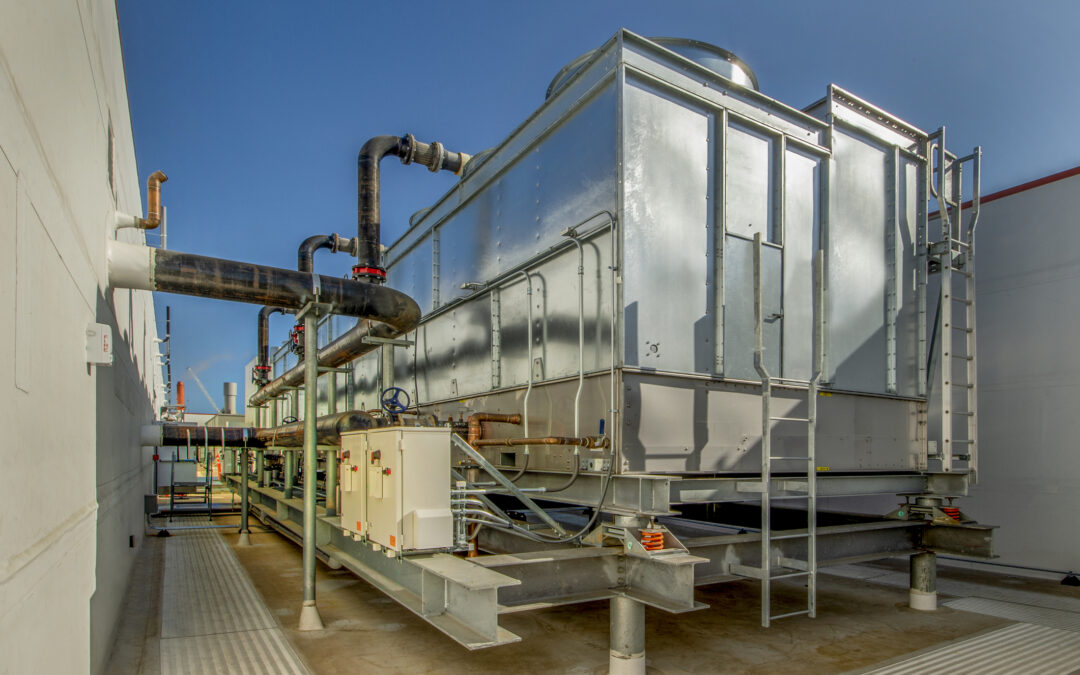Heat pump loops are responsible for both heating and cooling purposes in many commercial and residential buildings. These loops require heat rejection and the most commonly used coolers are dry and evaporative. Do you know the differences between the two and which is best for your building and location?
Heat pump loops operate based on the principle of transferring energy (heat) from one area to another via a pump using a fluid, usually water or glycol. The heart of the system is the heat pump itself which is made up of a compressor, condenser, expansion valve, and evaporator. The evaporator and condenser coils act as heat exchangers and are located inside the building.
The fluid circulates throughout the system absorbing heat at low temperatures and releasing it at high temperatures. When the fluid temperature gets too hot for the loop to work effectively, the fluid is sent through a cooler. Typically, these coolers are either “dry” or “wet” (evaporative).
| Dry Coolers | Evaporative Coolers |
|---|---|
Use air to cool the system process fluid Do not add moisture to the air Are suitable for a wide range of climates and work better in cooler ambient temperatures Function similar to a car’s radiator | Keep the process fluid out of direct contact with air and pump it through coils (with water flowing across) instead Add moisture to the air as part of the process Are most effective in dry climates where the air has low humidity Allow heat pumps to be more energy-efficient as they provide a cooler fluid temperature |
Dry Coolers
Dry coolers remove heat through a process of heat rejection. The lack of water (and the need for water treatment by extension) reduces the relative maintenance the system requires. They are particularly suitable in mild or cool climates where the ambient air temperature remains lower than the desired cooling temperature. Dry coolers are also compact and can be installed on rooftops or other limited-space areas. Since they don’t require extensive infrastructure and associated water systems, they make for a practical solution when space is a constraint.
Did you know that dry coolers are commonly employed in cooling applications, such as data centres, server rooms, and industrial facilities? These environments often require precise temperature control, and dry coolers can provide the necessary cooling capacity without the risk of water contamination associated with evaporative cooling methods. Dry coolers also produce less noise compared to cooling towers, which can be advantageous in commercial buildings.
Evaporative Coolers
An evaporative cooler, also known as an evaporative condenser, uses the principles of evaporative cooling for heat rejection. In this setup, water passes through a condensing coil that has a recirculated water system to stay wet and maintain a lower temperature. Evaporation occurs, which removes heat from the water in the condensing coil, and fans then push the heated vapour outside. This evaporation process cools the condenser coil more effectively than air would alone, resulting in improved heat rejection efficiency.
The cooled condenser coil allows the heat pump system to operate at lower temperatures, improving performance and energy efficiency. The evaporative cooler can be particularly beneficial in areas with high ambient temperatures or dry climates, where traditional air-cooled systems may struggle to achieve efficient heat rejection.
Hybrid Coolers
Hybrid coolers (or adiabatic systems) offer a combination of both options. These coolers can switch between evaporative and dry cooling modes based on the outdoor temperature and humidity levels, providing optimal cooling efficiency throughout the year. Evaporative cooling is used on hot days while dry cooling is relied on for the rest. Hybrid products help to reduce maintenance, provide low process temperatures, and optimize energy and water efficiency.
The choice between dry and evaporative coolers depends on building factors such as humidity, energy efficiency goals, size, occupancy patterns, and specific cooling requirements. Contact Alliance today so we can review your needs and engineer the right solution for you!

